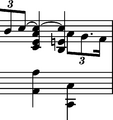



|
b. 9
|
composition: Op. 49, Fantaisie in F minor
..
The category imprint: Differences between sources; Corrections & alterations issues: EE revisions , Inaccuracies in GE |
||||||||||
|
b. 9
|
composition: Op. 49, Fantaisie in F minor
..
An arpeggio preceded by a grace note, resulting in a repetition of the bottom chord note, belongs to Chopin's favourite ornaments – cf. e.g. bars 18 and 320 or the Polonaise in F category imprint: Differences between sources issues: EE revisions |
||||||||||
|
b. 10
|
composition: Op. 49, Fantaisie in F minor
..
For the 3rd crotchet in the bar we choose the unquestionable A version (→GE). The same version, although written down with errors, is to be seen in FE1. The mistakes were corrected in FE2, yet, according to us, another mistake was committed in the act – the topmost note was changed from a category imprint: Interpretations within context; Differences between sources; Corrections & alterations issues: EE revisions , Errors in FE , Errors resulting from corrections , Terzverschreibung error , Annotations in FES , Authentic corrections of FE , Authentic post-publication changes and variants , Annotations in FEJ , FE revisions |
||||||||||
|
b. 10
|
composition: Op. 49, Fantaisie in F minor
..
In the main text we do not include the triplet slurs present in some sources (cf. General Editorial Principles, p. 16), especially since Chopin did not write them in A. category imprint: Differences between sources issues: EE revisions |
||||||||||
|
b. 14-15
|
composition: Op. 49, Fantaisie in F minor
..
The missing tie to a category imprint: Differences between sources issues: Errors in GE |

 in
in  minor, Op. 44, bar 27 and analog. Therefore, it seems unlikely that the small slur added in
minor, Op. 44, bar 27 and analog. Therefore, it seems unlikely that the small slur added in  1 in
1 in 